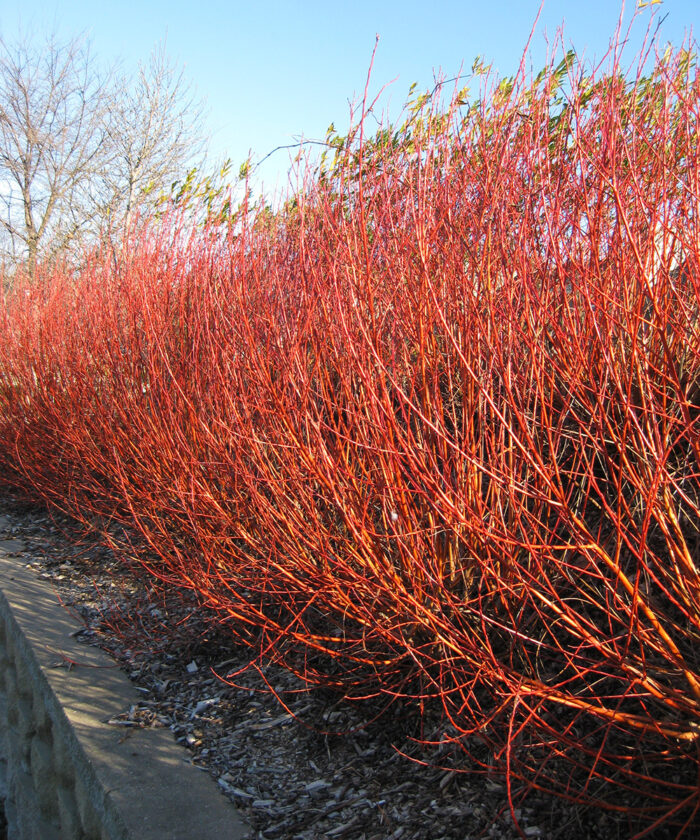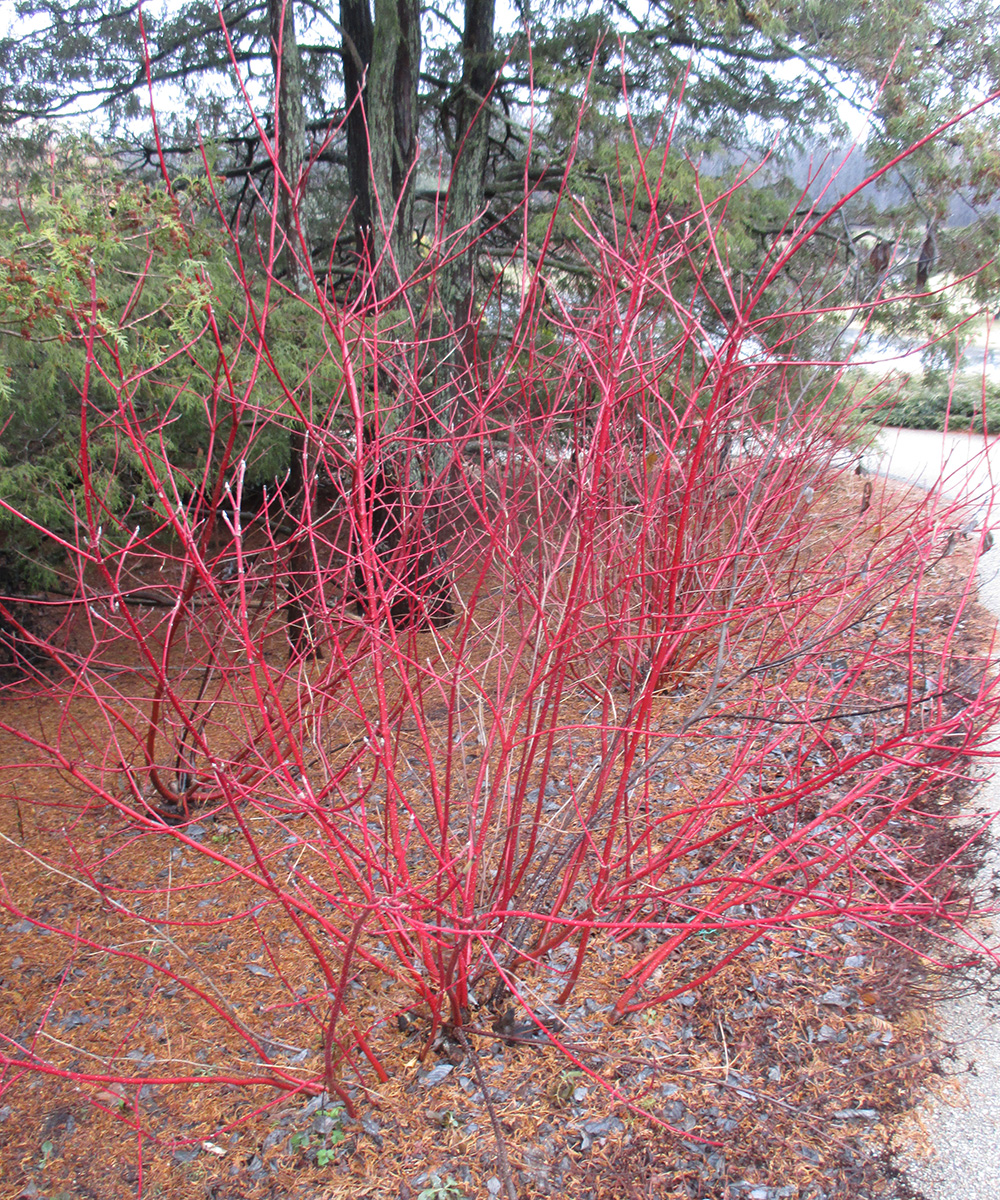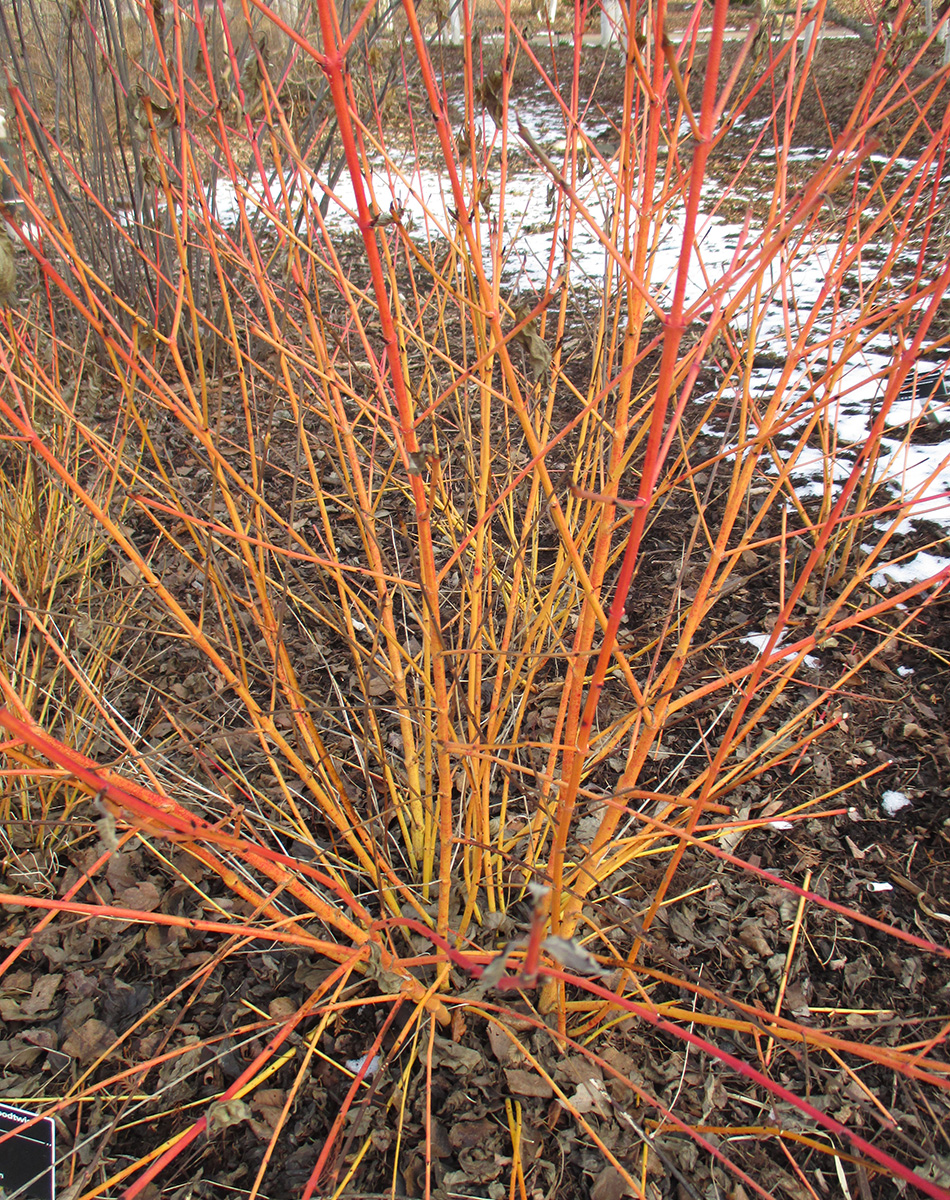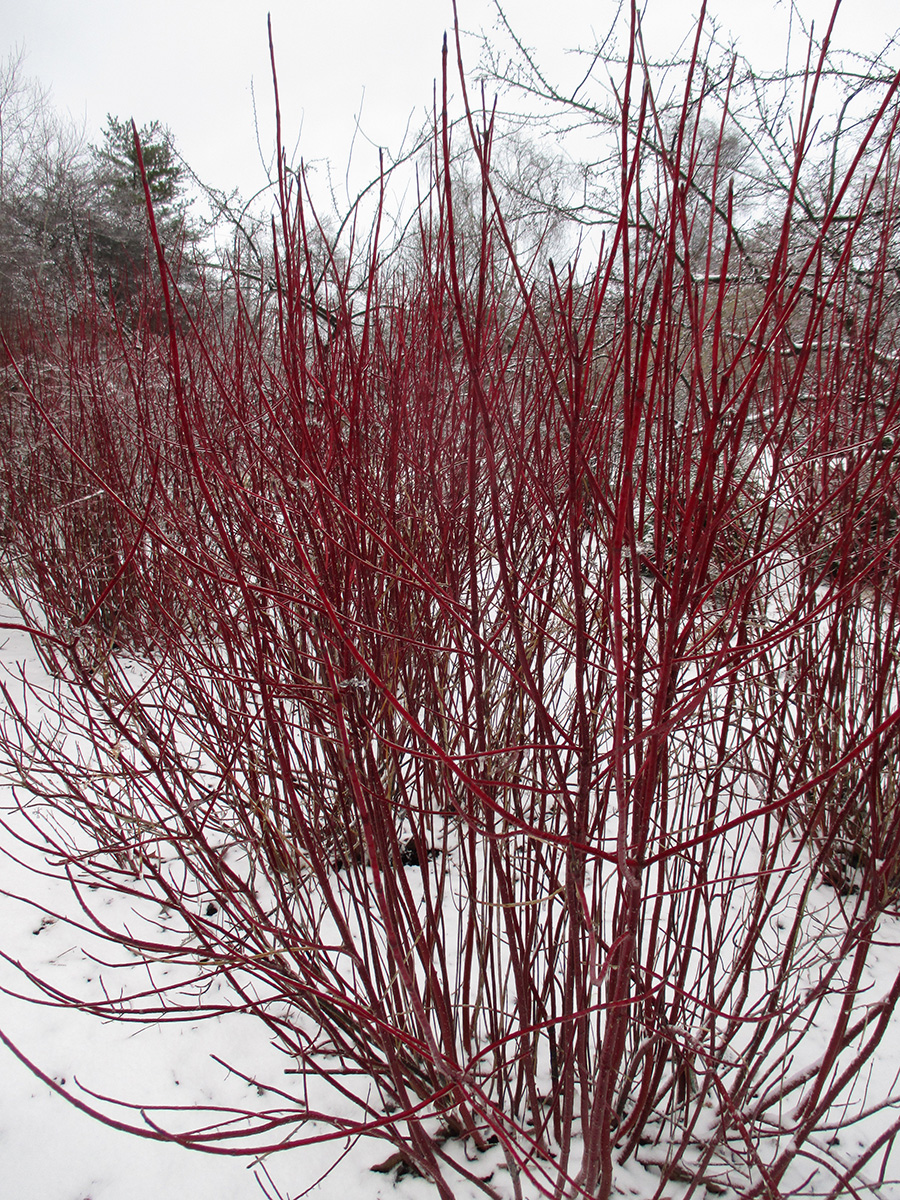
Winter in the Midwest doesn’t have to mean an absence of bright color. Of course we should be enjoying textures provided by our ornamental grasses, dormant perennials, and other plantings while the color and form of conifers becomes increasingly more impactful in the dormant landscape. The colorful fruits of many woody plants, including crabapples (Malus spp. and cvs., Zones 2–8), hawthorns (Crataegus spp. and cvs., Zones 3–9) and mountain ashes (Sorbus spp. and cvs., Zones 2–6) offer fleeting impact until they fade or are consumed by local wildlife. Ornamental bark from many of our larger shrubs and trees can also offer some dynamic texture and coloration over the long winter months. However, brightly colored stems of some select shrubs can enliven any landscape by providing warm colors throughout the cold months. These plants are also dynamic workhorses during the growing season when combined with other plantings and combinations. Some varieties also have ornamental foliage. In all cases, the winter stem coloration intensifies after leaves have dropped in autumn and the stems receive the combination of more sunlight and dropping temperatures.

This article focuses on some of the most colorful of dogwoods (Cornus spp. and cvs., Zones 3–9) and willows (Salix spp. and cvs., Zones 4–9). These selections are tried and true not only for their solid stem coloration in winter but also for their hardiness, broad adaptability, and value in the home landscape. It is important to note that in regard to all of these selections, it is the youngest growth and newer stems that offer the best coloration. This means that a frequent rejuvenation approach of removing older stems (typically 1/3 annually) of dogwoods in early spring will encourage new growth to sprout and take over the show of color in time. The willows require a more substantial approach, with extremely severe annual cutting in very early spring both to encourage quick new growth with intense coloration the following winter and to keep the plants in scale with the landscape. Willows strive to be large and aggressive, so an annual approach to pruning will keep them in check and encourage as much as 6 to 8 feet of brand-new growth per season that will be intensely colorful.

Ivory Halo® tatarian dogwood
Cornus alba ‘Bailhalo’, Zones 3–7
This dogwood is one of my personal favorites. The deep, maroon-red stems are certainly beautiful in the winter landscape, particularly when emerging from fresh snow. Aside from the compact nature and durability of this selection, strongly variegated leaves offer interest throughout the growing season. Ivory Halo® will grow 6 feet tall and wide.

‘Britzensis’ coral bark willow
Salix alba subsp. vitellina ‘Britzensis’, Zones 4–8
I was first introduced to this variety over 10 years ago in a snowy Wisconsin landscape where multiple specimens glowed with orange-red stems. After realizing it was technically a white willow, I did more research on this amazing plant. It’s important to mention that this selection gets big—15 feet tall and 10 feet wide if allowed. Additionally, the older stems will start to lose the intensity of winter coloration. To offset this, a severe cutback in early spring (after enjoying the winter stem color, of course) is recommended. This will encourage vigorous new growth, a more restrained size, and nice stem color the following winter.

‘Prairie Fire’ tatarian dogwood
Cornus alba ‘Prairie Fire’, Zones 3–7
The bright red winter stems alone make this selection of dogwood worth planting. The foliage color is a bright yellow-gold from spring emergence all the way through autumn. This variety is a golden beacon in the landscape until the leaves drop in autumn and stem coloration intensifies. ‘Prairie Fire’ will grow 8 feet tall and wide.

‘Winter Beauty’ bloodtwig dogwood
Cornus sanguinea ‘Winter Beauty’, Zones 4–7
This striking dogwood is vigorous during the growing season and comes into the most beautiful stem coloration in winter. Stems are yellow and orange with more intense red at the ends. This tricolor effect is not subtle and captures attention quickly. At maturity, ‘Winter Beauty’ reaches 6 feet tall and wide.

‘Flame’ willow
Salix ‘Flame’, Zones 3–7
Of all the plants in this article for winter stem coloration, I would argue that ‘Flame’ willow is the most intense. Similar to ‘Britzensis’, this variety wants to get fairly tall. It will grow 15 feet tall and 8 feet or wider if allowed. In doing so, it will only show the best stem coloration at the stem tips (newest growth). A severe cutback is recommended for this selection as well, which can result in 6 feet or more of new, quickly sprouting growth. Once the leaves (nice yellow fall color) drop, the stems transition to a fiery orange-red.

‘Silver and Gold’ yellow-twig dogwood
Cornus sericea ‘Silver and Gold’, Zones 3–8
This selection of redosier dogwood features bright yellow stems in the winter months. Prior to this showy stem effect, ‘Silver and Gold’ has variegated foliage that is quite showy from spring emergence to fall leaf drop. The intensity of the yellow stems increases in winter. Other excellent yellow stem selections include ‘Flaviramea’ and ‘Bud’s Yellow’. ‘Silver and Gold’ will grow 7 feet tall and 8 feet wide at maturity.

‘Bergeson Compact’ redtwig dogwood
Cornus sericea ‘Bergeson Compact’, Zones 3–8
I’m a big fan of this selection for two reasons. The winter stem coloration is a very rich wine-red that really shines in a snowy or drab landscape. This is also one of the best compact forms on the market and requires less work to maintain in terms of moderating overall size. However, as with the other dogwood selections, it will need some rejuvenation pruning. At maturity, ‘Bergeson Compact’ will reach 6 feet tall and wide.

‘Swizzle Stick’ willow
Salix ‘Swizzle Stick’, Zones 3–8
This is a relatively new willow for me, although I first encountered it in winter. I immediately noticed its yellow-orange stems and the contorted nature of every stem. The parentage of this willow is up for debate, but do note that this selection would like to grow into a small tree (20 feet tall and 8 feet wide or larger if allowed to grow), so periodic rejuvenation pruning or severe cutting back will result in a more manageable size if desired. The overall form of this willow is quite columnar, so the ultimate desired size may be quite a bit tall to appreciate the unique contortion of individual stems as well as the winter stem coloration.
All of the dogwoods in this article take full to partial sun, and the willows take full sun. For other recommendations for winter color in your landscape, read on here:
- Winter Stars: Bare Yet Beautiful Plant Varieties
- Wonderful Willows for the Midwest
- Intriguing Bark Enlivens a Winter Scene
- Ornamental Bark on Deciduous Trees in the Midwest
Mark Dwyer, former director of horticulture at Rotary Botanical Gardens in Janesville, Wisconsin, operates Landscape Prescriptions by MD.
Fine Gardening Recommended Products

Sun Joe Cordless Telescoping Pole Chain Saw
Fine Gardening receives a commission for items purchased through links on this site, including Amazon Associates and other affiliate advertising programs.

Pruning Simplified: A Step-by-Step Guide to 50 Popular Trees and Shrubs
Fine Gardening receives a commission for items purchased through links on this site, including Amazon Associates and other affiliate advertising programs.

ARS Telescoping Long Reach Pruner
Fine Gardening receives a commission for items purchased through links on this site, including Amazon Associates and other affiliate advertising programs.



















Comments
Log in or create an account to post a comment.
Sign up Log in